
Thursday, October 16, 2008
A Visitor
Today we had a visitor:
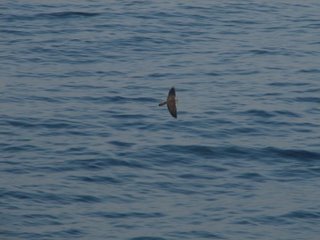
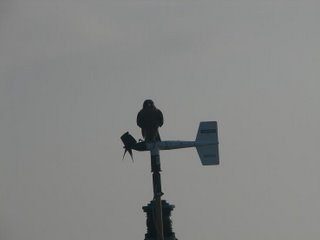 This bird came by for a visit. I think is a type of hawk or a falcon. Can anyone identify it for me? We have been trying but can't seem to figure out what kid of hawk this is. In any case, it stopped by and perched on the bow just out of the blue when we were about 80 miles from shore. I wonder how it got here? Was it blown out to sea by a storm? Did it follow a ship looking for food? Is it lost? I hope it finds its way back.
This bird came by for a visit. I think is a type of hawk or a falcon. Can anyone identify it for me? We have been trying but can't seem to figure out what kid of hawk this is. In any case, it stopped by and perched on the bow just out of the blue when we were about 80 miles from shore. I wonder how it got here? Was it blown out to sea by a storm? Did it follow a ship looking for food? Is it lost? I hope it finds its way back.
It was foggy during the early morning and the ship had to blow its fog horn. I found out that ships use a code when they sail. One long blast means we are steaming ahead. One long and two short blasts means we have equipment such as nets in the water and cannot manuver as quickly. Listen by clicking here.
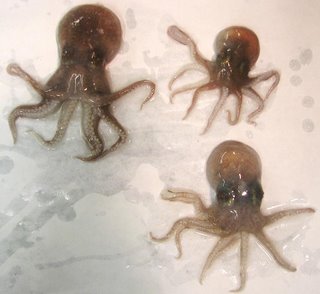 We found more spoon armed octopi. Can you see that one of the arms has a little spoon like object at the end? The male has an arm shaped like a spoon. Can you see it in this picture?
We found more spoon armed octopi. Can you see that one of the arms has a little spoon like object at the end? The male has an arm shaped like a spoon. Can you see it in this picture?
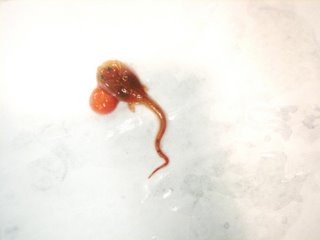
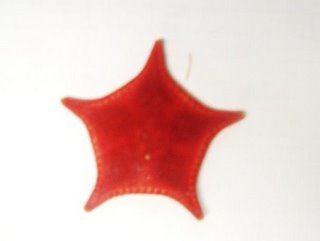 This is a red gold-bordered sea star. Isn't it amazing how many different kinds of sea stars there are in the ocean!
This is a red gold-bordered sea star. Isn't it amazing how many different kinds of sea stars there are in the ocean!
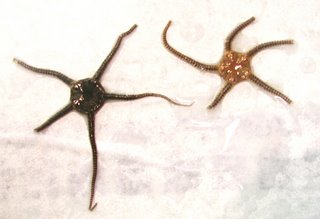
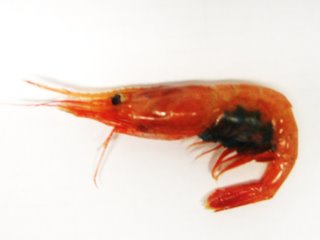
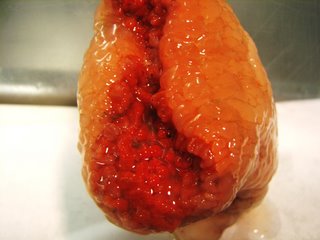
A sea anemone. This opens up and tenticles appear. They wave their tenticles in the water to collect food. When fish like Nemo, the clown fish, go into a sea anomone, it will sting the fish, so the clown fish backs in which helps it tolerate the sting.
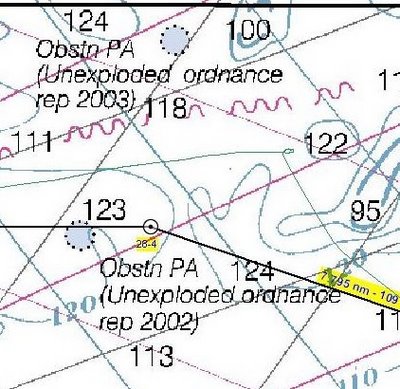
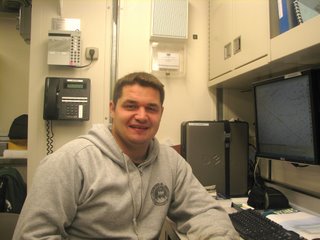
Mrs. Christie-Blick's Class:
You asked some AMAZING questions. I'm so proud of you guys. Drl Kunkel was impressed as well. Here is what He told me:
You asked: What is your proof that these lobster shells are softer than other lobster shells? How do you measure hardness:
We have an engineering department at U Mass and one of the projects they have to do to become materials engineers is to test for hardness and they do an indentation test. Another way is to shoot x rays at shell and we can tell how hard it is by how the x rays scatter.
You asked: What is causing the harmful bacteria in the water?
We don't know if they are harmful bacteria. My theory is that it could be the same normal bacteria that are on the backs of healthy lobsters. We think it is the weakness in the new lobster shells because of environmental influences south of Cape Cod that causes the trouble.
You asked: Can you get rid of the harmful bacteria?
It is possible to reverse the environmental conditions that have been created by us or by mother nature.
Hag fish did gross me out a little. Interestingly, there is no way to determine the age of this fish as there are with others, so I'm not sure we can even tell you how long they live.
Several of you asked about the red dots on the lobster. They are a disease. It is called shell disease.
This baby skate has a yolk sack still attached to it. The baby uses the yolk as food while it grows. Usually this happens in the skate case. I wonder what happened with this little guy.
These two are called brittle stars. Here is a video of them moving around. I am always amazed at how fast they are.
This is a shrimp close up. Can you guess what the blue mass is under her back end? Post your answers to the blog.
A sea anemone. This opens up and tenticles appear. They wave their tenticles in the water to collect food. When fish like Nemo, the clown fish, go into a sea anomone, it will sting the fish, so the clown fish backs in which helps it tolerate the sting.

Here is an interesting story: We were approaching a station where we were expecting to take a 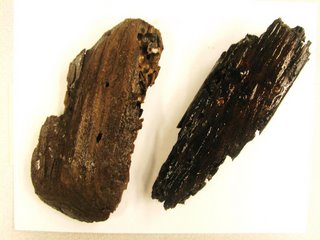 sample from the water with our nets. Do you see the note in the chart that says “Unexploded Ordinance?” (you can click on the chart to make it bigger). that means there are bombs from an old ship that may still be active! We decided to move our trawl to a nearby area. When we did, look what came up in the nets! Part of an old ship! The coordinates are Latitude: 42°27'23.65"N and Longitude: 68°51'59.12"E. Here is that location on Google Earth. What could have happened way out here? CLE students, tell me the story of that wreck. Be creative. Please print them out and leave them for me on Monday. Make them fun to read. I am bringing back what came up in the net for you to see. When I get back, we will see if we can do some research and find out what really happened!
sample from the water with our nets. Do you see the note in the chart that says “Unexploded Ordinance?” (you can click on the chart to make it bigger). that means there are bombs from an old ship that may still be active! We decided to move our trawl to a nearby area. When we did, look what came up in the nets! Part of an old ship! The coordinates are Latitude: 42°27'23.65"N and Longitude: 68°51'59.12"E. Here is that location on Google Earth. What could have happened way out here? CLE students, tell me the story of that wreck. Be creative. Please print them out and leave them for me on Monday. Make them fun to read. I am bringing back what came up in the net for you to see. When I get back, we will see if we can do some research and find out what really happened!
Now lets meet Phil Politis, our Chief Scientist on board the Bigelow. I asked him to tell us about his job. Here is what he said:
The main job of a chief scientists is to meet the goals and objectives of the the scientific mission. In our case, that is, to pair up with the ship Albatross in as many stations as possible, following their route. My day to day job is to coordinate with the officers, and crew, setting the nets properly, make sure that the samples are processed properly and solving problems as they arise. Say we have an issue with the nets. It is the chief scientists job to decide what to do next. I can accept the tow, code it as a problem, or re-do the tow. I have to look at each issue individually. If we tear on the bottom, will it happen again? Is there time to re-tow? I also coordinate with the other vessel.
My title is fisheries biologist, but I am a specialist in the nets. My background is in trawl standardization. We have to ensure that our nets are constructed, maintained and that we fish same way each time. Small changes in nets can effect how the nets fish and that effects the study. That way we can compare this years catch to next years catch. Remember, this study is called a time series. Over time, you can see changes to fish population. The only way you can trust those numbers is if the nets are the same each time we put them in the water year after year, tow after tow. We have to document what we are doing now so that in the future, people know how and what we were doing. This way the time series remains standard. We have to standardize materials the nets are made of, way they are repaired. We inspect the nets each time we come on here. We train the deck crews in the maintenance and repair of our nets.
-------------------------------
In answer to many of your questions, I will be back to SOCSD on Monday. I'll be in WOS on Monday and CLE on Tuesday. See you then.
My title is fisheries biologist, but I am a specialist in the nets. My background is in trawl standardization. We have to ensure that our nets are constructed, maintained and that we fish same way each time. Small changes in nets can effect how the nets fish and that effects the study. That way we can compare this years catch to next years catch. Remember, this study is called a time series. Over time, you can see changes to fish population. The only way you can trust those numbers is if the nets are the same each time we put them in the water year after year, tow after tow. We have to document what we are doing now so that in the future, people know how and what we were doing. This way the time series remains standard. We have to standardize materials the nets are made of, way they are repaired. We inspect the nets each time we come on here. We train the deck crews in the maintenance and repair of our nets.
-------------------------------
In answer to many of your questions, I will be back to SOCSD on Monday. I'll be in WOS on Monday and CLE on Tuesday. See you then.
Mrs. Christie-Blick's Class:
You asked some AMAZING questions. I'm so proud of you guys. Drl Kunkel was impressed as well. Here is what He told me:
You asked: What is your proof that these lobster shells are softer than other lobster shells? How do you measure hardness:
We have an engineering department at U Mass and one of the projects they have to do to become materials engineers is to test for hardness and they do an indentation test. Another way is to shoot x rays at shell and we can tell how hard it is by how the x rays scatter.
You asked: What is causing the harmful bacteria in the water?
We don't know if they are harmful bacteria. My theory is that it could be the same normal bacteria that are on the backs of healthy lobsters. We think it is the weakness in the new lobster shells because of environmental influences south of Cape Cod that causes the trouble.
You asked: Can you get rid of the harmful bacteria?
It is possible to reverse the environmental conditions that have been created by us or by mother nature.
You are right about these sources of pollution. Good thinking. And yes, Dr. Kunkel believes that one or more of these factors may be hurting the lobsters. The problem area is south of Cape Cod. Look on a map today and count the number of cities between New York and Boston. Is this an area with a lot of people and pollution or is this an area that is sparsely populated?How would you expect this area to compare to areas where the lobster population is healthier off of Maine and Nova Scotia? Do the problem areas for the lobster and the pollution occur in the same ar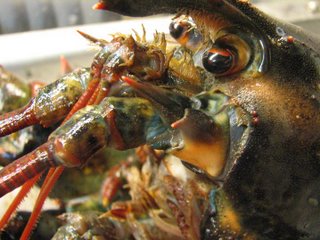 ea? If they match, scientists say there is a correlation between the two and they wonder if one is causing the other. What do you think?
ea? If they match, scientists say there is a correlation between the two and they wonder if one is causing the other. What do you think?
Hag fish did gross me out a little. Interestingly, there is no way to determine the age of this fish as there are with others, so I'm not sure we can even tell you how long they live.
Several of you asked about the red dots on the lobster. They are a disease. It is called shell disease.
The lobster on the right is healthy. I just love this picture so I thought I would share it.
SR, the water temperature is about 16 degrees C last time I checked.
MF, nice to meet you. It is really cool to be a Teacher At Sea.
DTR, my favorite thing about this trip is working with you guys from the middle of the ocean.
MR, Snuggy and Zee are having loads of fun touring the ship.
CF: I will try to count the teeth of a fish and tell you what I find. Sometimes they are hard to see. I do not know if I am going back next year, but I hope so. I like being at sea. The truth is, I like being on land too. Both are nice. Thanks for writing.
BS: No, we find mostly adults, but some babies. Many creatures are small as adults.
BV: We have seen lots of jellyfish. We had so many we had to hose down the lab at the end of our session the other day. They were everywhere.
GS: We will continue to take samples here.
TL and Many Others asked how long we put the cups down for: We put the cups down for about 15 minutes. That includes the time it takes to lower the CTD to the bottom. When it gets to the bottom, it comes right back up. Thanks all for writing.
AS: Right you are!
Good job calculating all those who got 984 feet!
MM, I love the adventures I'm having here and the people I am meeting. It has been fun. I like being on land too.
JS, Dr. Kunkel took samples from some lobsters so he could help cure the disease.
KF: Could the hag fish bit us? Yes, Mel Underwood, our Watch Chief was very careful as she held the bag and backed her hands up when the fish got close to her hands. Mel is very experienced working with sea life and I have never seen her back off the way she did with this thing.
HRF: Go for it! It is a cool job!
CF: Good question. No, your bones are a lot stronger than styrofoam, so you would have to go down many miles to hurt yourself, and you could not swim that far without gear. When divers get hurt from pressure changes, it is usually something different called the bends. This happens when you are swim up to fast and certain gases in your blood stream expand as the pressure increases and form bubbles that can hurt you. Divers have to swim up slowly (the usual rule is don't go up faster than the air bubbles next to you) in order to avoid getting the bends.
DC: Good questions: The dots are not bacteria on the lobster, they are the result of the bacteria eating away parts of the shell. The actual bacteria are too small to see. Good question about he temperature relating to growth. It is a bit more complex than that. There are many factors at work. The factor that may be causing more bacteria are chemicals like fertilizers from land getting into the water.
Dr. Kunkel came on board to study lobsters. He is a biologist, not a medical doctor. There are many scientists on board working with us, and me with them.
The quadrent is an old invention. People have been able to find their way with the stars for thousands of years. It is an ancient art. It was fun to practice it here.
SF, VF and others: The fish stayed in the bag. We made sure of that. From the bag, we put it back in the sea.
SD, sorry, I can't help you there. I don't think a pet skate would survive the trip back to NY.
Several of you have asked if I have gotten sick. No, I have not.
How many lobsters have we caught so far? Lots!
SS, sleeping on a boat if fun. If the waves are small, they rock you to sleep. If they are huge, however, they throw you out of bed!'
CP: bacteria infect the shells of the lobsters. This destroys the protection that the lobster should have. They grow weak and die of other causes. Good question!
Why do we work at night? Because ships work 24 hours a day so that no time is wasted. I ended up on the night shift. Why do we wear suits? To stay warm and dry on deck.
The hagfish eat shrimp and small fish, though they are scavengers and can eat large creatures as well.
Mrs. Christie Blick's Class, you guys are doing some great work. I check on the skates for you. Some skates have protection, like thorns or spikes. They also have some interesting fins that look almost like feet. They use these to “walk” along the bottom searching for food. I know you asked about skates, but I have to mention the ray I worked with yesterday. It is related to the skate and could shock with an electrical charge for both protection and for hunting prey. Cool!
SR, the water temperature is about 16 degrees C last time I checked.
MF, nice to meet you. It is really cool to be a Teacher At Sea.
DTR, my favorite thing about this trip is working with you guys from the middle of the ocean.
MR, Snuggy and Zee are having loads of fun touring the ship.
CF: I will try to count the teeth of a fish and tell you what I find. Sometimes they are hard to see. I do not know if I am going back next year, but I hope so. I like being at sea. The truth is, I like being on land too. Both are nice. Thanks for writing.
BS: No, we find mostly adults, but some babies. Many creatures are small as adults.
BV: We have seen lots of jellyfish. We had so many we had to hose down the lab at the end of our session the other day. They were everywhere.
GS: We will continue to take samples here.
TL and Many Others asked how long we put the cups down for: We put the cups down for about 15 minutes. That includes the time it takes to lower the CTD to the bottom. When it gets to the bottom, it comes right back up. Thanks all for writing.
AS: Right you are!
Good job calculating all those who got 984 feet!
MM, I love the adventures I'm having here and the people I am meeting. It has been fun. I like being on land too.
JS, Dr. Kunkel took samples from some lobsters so he could help cure the disease.
KF: Could the hag fish bit us? Yes, Mel Underwood, our Watch Chief was very careful as she held the bag and backed her hands up when the fish got close to her hands. Mel is very experienced working with sea life and I have never seen her back off the way she did with this thing.
HRF: Go for it! It is a cool job!
CF: Good question. No, your bones are a lot stronger than styrofoam, so you would have to go down many miles to hurt yourself, and you could not swim that far without gear. When divers get hurt from pressure changes, it is usually something different called the bends. This happens when you are swim up to fast and certain gases in your blood stream expand as the pressure increases and form bubbles that can hurt you. Divers have to swim up slowly (the usual rule is don't go up faster than the air bubbles next to you) in order to avoid getting the bends.
DC: Good questions: The dots are not bacteria on the lobster, they are the result of the bacteria eating away parts of the shell. The actual bacteria are too small to see. Good question about he temperature relating to growth. It is a bit more complex than that. There are many factors at work. The factor that may be causing more bacteria are chemicals like fertilizers from land getting into the water.
Dr. Kunkel came on board to study lobsters. He is a biologist, not a medical doctor. There are many scientists on board working with us, and me with them.
The quadrent is an old invention. People have been able to find their way with the stars for thousands of years. It is an ancient art. It was fun to practice it here.
SF, VF and others: The fish stayed in the bag. We made sure of that. From the bag, we put it back in the sea.
SD, sorry, I can't help you there. I don't think a pet skate would survive the trip back to NY.
Several of you have asked if I have gotten sick. No, I have not.
How many lobsters have we caught so far? Lots!
SS, sleeping on a boat if fun. If the waves are small, they rock you to sleep. If they are huge, however, they throw you out of bed!'
CP: bacteria infect the shells of the lobsters. This destroys the protection that the lobster should have. They grow weak and die of other causes. Good question!
Why do we work at night? Because ships work 24 hours a day so that no time is wasted. I ended up on the night shift. Why do we wear suits? To stay warm and dry on deck.
The hagfish eat shrimp and small fish, though they are scavengers and can eat large creatures as well.
Mrs. Christie Blick's Class, you guys are doing some great work. I check on the skates for you. Some skates have protection, like thorns or spikes. They also have some interesting fins that look almost like feet. They use these to “walk” along the bottom searching for food. I know you asked about skates, but I have to mention the ray I worked with yesterday. It is related to the skate and could shock with an electrical charge for both protection and for hunting prey. Cool!
Comments:
<< Home
Hi Mr.T
How are you doing?
im doing well
umm i heard that your coming this week. When you first went were you scared of the animals? Well I saw the animals in the blog but its so funky. well gotto go!~
From
J.
How are you doing?
im doing well
umm i heard that your coming this week. When you first went were you scared of the animals? Well I saw the animals in the blog but its so funky. well gotto go!~
From
J.
Hi Mr. T how is it up there. I just wanted to ask you how do star fish get there shape? have you ever had a problem on the ship before? I just wanted to anser the questoin the you asked on your blog I think its a falcon.
Dear Mr. T,
I love to see what you are doing. Did you get to eat any lopster yet? Did you see any sharks or poison fish?
From
B.B.
I love to see what you are doing. Did you get to eat any lopster yet? Did you see any sharks or poison fish?
From
B.B.
Hi Mr.T
I was just wondering why do some of the lobsters have spots?
Can it be from global warming? How is the pollution in the water there? I s it a problem?
CG
I was just wondering why do some of the lobsters have spots?
Can it be from global warming? How is the pollution in the water there? I s it a problem?
CG
Dear Mr T,
Hi,my favorite thing that you did was when you got the big cups and then you put them in the sea then when you pulled the the cubs up the where small.Why did the lobster had spots was he sick?
Hi,my favorite thing that you did was when you got the big cups and then you put them in the sea then when you pulled the the cubs up the where small.Why did the lobster had spots was he sick?
Hi Mr.T
I was just wondering about the lobster.I was really wondering what was on the lobster it was life freckles.I hope you find out what it was!Good luck!!!I guess it was chicken pocks?...
I was just wondering about the lobster.I was really wondering what was on the lobster it was life freckles.I hope you find out what it was!Good luck!!!I guess it was chicken pocks?...
Dear Mr.T
how come some of the styrafoam cups didnt crush. was it because they didnt go down far anoughf.
how come some of the styrafoam cups didnt crush. was it because they didnt go down far anoughf.
Dear Mr T
Those creacrers and facts are very
cool.That video of the wetlab was
incredibal.Also the dogfish that
was awsome. Hope you have a nice
trip home.
from
MS TZE
Those creacrers and facts are very
cool.That video of the wetlab was
incredibal.Also the dogfish that
was awsome. Hope you have a nice
trip home.
from
MS TZE
mr.t do you now how much the shrimp wates also if you now were the cups started to crush tipe back plese.
Dear Mr.T
Hi Mr.T I was wondering how the Octopi look like when they are fuly grown.How is Zee and Snuggy.Did they make any friends with the sea creachures.
from VP
Hi Mr.T I was wondering how the Octopi look like when they are fuly grown.How is Zee and Snuggy.Did they make any friends with the sea creachures.
from VP
Dear Mr. T,
We learned about the styrophone cup
experiment. I can't believe the styrophone cups went all the way to the bottom of the sea. The water pressure crushed them.
AS
We learned about the styrophone cup
experiment. I can't believe the styrophone cups went all the way to the bottom of the sea. The water pressure crushed them.
AS
Dear MR Tannebaun yuo know the visiter of today did the bird falow
the ship and how thei due fire drils at sea and wee saw all of the cups in the vaton of the sea.
ss
the ship and how thei due fire drils at sea and wee saw all of the cups in the vaton of the sea.
ss
Mr. T the cup are cool when its in the water I miss you so much I hope u are nice and warm.Please come back safe. love, k.l
Hello Mr.T I saw your Experements they were cool. Are you exited to come home soon!!! I saw the video of the paper cup going into the bottom of the sea. Did you have a good jouney at the atlantic ocean. On the window there is a huge primantis.Have you seen whals or sharks? I cant wait in till you come back !!! from A.W
Hi Mr T I saw the video of the styla form cups.i thought that when you put the cups downinto the ocean . those are cool sea creatures. well class is over now email me back.........
HI Mr.T today the class learned about the changing ecosystem.How do these creatures adapt to the cold of the seafloor.Oh, did you find the thing with eight eyes and 2two heads?
signed
Anonymous
signed
Anonymous
dear Mr Tanenvalm
in class we learned that when you put styraphone cups 200 meters in the ocean the water pressure will make them smaller. We hope that global warming won't hurt the
eco system.
from
ian
in class we learned that when you put styraphone cups 200 meters in the ocean the water pressure will make them smaller. We hope that global warming won't hurt the
eco system.
from
ian
Dear mr.T what i want to know is how dose the preasure of water make things smaller?Its really interesting. from A.R.
Dear Mr T
Today we learned about the changing ecosystem of the ocean.
We also some of the fish you found.We also heard about the water pressure under the water.
We saw that your cups shrank!
g2g
Today we learned about the changing ecosystem of the ocean.
We also some of the fish you found.We also heard about the water pressure under the water.
We saw that your cups shrank!
g2g
Hi Mr.T!!!!!! How is the boat goin? I hope it is good. I miss you. Today in class we watched the video about the styrofoam cups. Its so cool!!! Its so cool to watch the cups turn from big to small!
Water presure is soooo cool!!
Your student
GS
Water presure is soooo cool!!
Your student
GS
Hi Mr.T
Your lucky that your ship has computers and a tecnology room.
Columbus didnt. Columbus had to do it with wind. And the sun and the stars. He didnt have a gps like you. He had his own kind of gps it counted latitude and longitude. If it was a very windy day it would cause a lot of problems. Have a nice trip!
Your lucky that your ship has computers and a tecnology room.
Columbus didnt. Columbus had to do it with wind. And the sun and the stars. He didnt have a gps like you. He had his own kind of gps it counted latitude and longitude. If it was a very windy day it would cause a lot of problems. Have a nice trip!
Dear Mr. T
I heard about the experiments you are doing. I was wondering if you could try sending plastic or even paper cups down to the bottom of the ocean. I'm also wondering if animals like that lobster you found. Will they be okay?
Sincerly,
D.L.
I heard about the experiments you are doing. I was wondering if you could try sending plastic or even paper cups down to the bottom of the ocean. I'm also wondering if animals like that lobster you found. Will they be okay?
Sincerly,
D.L.
Dear Mr.T
I cant believe that those cups were really small!!!and the bird was kinda small so i think it was a sea bird but im not sure but i im gonna guess
I cant believe that those cups were really small!!!and the bird was kinda small so i think it was a sea bird but im not sure but i im gonna guess
Dear Mr.T,
On October 15, you were talking about glaciers melting and, how that could flood the earth. Although I thought that we are loosing water.How is both of these things happening at the same time?
From, CM(student from Ms.C-B's class)
On October 15, you were talking about glaciers melting and, how that could flood the earth. Although I thought that we are loosing water.How is both of these things happening at the same time?
From, CM(student from Ms.C-B's class)
Dear Mr.Tanenbaum
When you showed the picture with the skate that had the yolk sack,what would happen to it?? Would it die earlier or have a type of diease?? Anyway it was nice talking to you on the phone (in Ms.C-B's classroom.) And thanks for typing this blog, shooting the videos,and taking awsome pictures!!
From,
SP (student for Ms.C-B's class)
P.S. See you in school!!
When you showed the picture with the skate that had the yolk sack,what would happen to it?? Would it die earlier or have a type of diease?? Anyway it was nice talking to you on the phone (in Ms.C-B's classroom.) And thanks for typing this blog, shooting the videos,and taking awsome pictures!!
From,
SP (student for Ms.C-B's class)
P.S. See you in school!!
I am LW at TZE. ARe you getting sea sick? Because I hope not. I love your video about the cups. I liked it when I got to see the yellow teeth of the, I think, fish.
Hi Mr. Tanenbaum!
We're looking at our videos and pictures - thanx for sharing your wonderful experience at sea with all of us.
From JK and his mom.
We're looking at our videos and pictures - thanx for sharing your wonderful experience at sea with all of us.
From JK and his mom.
How is Zee and Snuggy?
I'm doing fine. This morning, I almost screamed when I saw a HUGE spider that looked like a horseshoe crab (hee hee). It scared me to death. Anyway are there huge spders on the ship?
If there are, tell me.
MA
Post a Comment
I'm doing fine. This morning, I almost screamed when I saw a HUGE spider that looked like a horseshoe crab (hee hee). It scared me to death. Anyway are there huge spders on the ship?
If there are, tell me.
MA
<< Home









